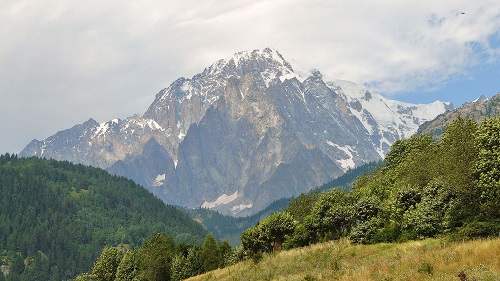Day, S., The Great Outdoors. Geoscientist
30 (4), 5, 2020
https://doi.org/doi: 10.1144/geosci2019-078,
Download the pdf here
 In 1802, a young English traveller stood in a Swiss valley gazing up at Mont Blanc. In his notebook, he wrote ‘To gain a just delineation of a Swiss view the artist should consult his feelings as much as his sight…the tranquility of the Evening, the beautiful tints of the setting sun, the grandeur of the mountain had thrown me into such a mood which it is impossible to describe and rendered me in the highest degree susceptible of pleasure.’
In 1802, a young English traveller stood in a Swiss valley gazing up at Mont Blanc. In his notebook, he wrote ‘To gain a just delineation of a Swiss view the artist should consult his feelings as much as his sight…the tranquility of the Evening, the beautiful tints of the setting sun, the grandeur of the mountain had thrown me into such a mood which it is impossible to describe and rendered me in the highest degree susceptible of pleasure.’
You’d be forgiven for guessing that our mountaineer might be a romantic poet composing verses – Wordsworth, perhaps, or Coleridge. The Swiss Alps were a kind of rite of passage for poets and thinkers of the time – everyone seemed to be making the trip and composing verses, no doubt of varying quality, afterwards.
In this case, however, the author was none other than the Geological Society’s first President, George Bellas Greenough (1778-1855). Five years after that scene in the Alps, Greenough would be part of the group of thirteen men forming ‘a little geological dining club’ of like-minded friends.
Greenough isn’t exactly remembered now as a romantic figure, wandering about on hills and outcrops feeling poetical. If you think of him at all, it’s probably as a key player in the Geological Society’s poor treatment of William ‘Strata’ Smith, and the creator of the Society’s own geological map of the nation - published 200 years ago this year - which now hangs beside Smith’s at Burlington House.
Here’s what Coleridge had to say about Greenough, after a meeting in Gottingen in 1801: ‘I loved and esteemed you more than any I met there.’ When Coleridge took a trip to Malta in 1805, Greenough sent him off with a packet of dried soup, a bottle of brandy and a copy of Hauy’s ‘Mineralogy’, ‘packed up with Greenough’s neatness in one parallelogram of brown paper!’
Many poets and scientists in the early nineteenth century, as this months’ Soapbox reminds us, were engaged in lively discourse that might seem unusual to us now. There are lots of reasons for this, but perhaps, for geologists in particular, one of them is simply a love of the outdoors. ‘Surely there are times’, wrote Greenough in 1802, ‘when it is permitted to absent ourselves from the realities of life to indulge in reveries?’
It’s been hard, over the last few weeks, to indulge in reveries. For many of us, a geological career began with a love of the outdoors; a place which a few weeks ago became virtually inaccessible. It’s hard to know what the situation will be by early May, when you read this, but many of us are likely to still be spending much of our time working at home – this month, Clive Mitchell offers some tips that might help you through.
Our meeting report - usually accounts of conferences and workshops held indoors - comes this month from the Yorkshire Moors, as Mike Stephenson recounts a walk with the Yorkshire Geological Society in which the poetry of Ted Hughes and Ovid takes on new meaning. Our feature, too, is a reminder of how much geology takes place in the open air – in this case, on the site of an outcrop yielding exciting finds which could help us to better understand the Toarcian.
I hope you enjoy this month’s issue, particularly if it comes at a time when you’re unable to spend much time outside yourself. Most of all, I hope it finds you safe and well, and that we’ll all be outside again before too long. (Composition of dubious verses is optional.)
Sarah Day FGS, Editor
[email protected]
@geowriter